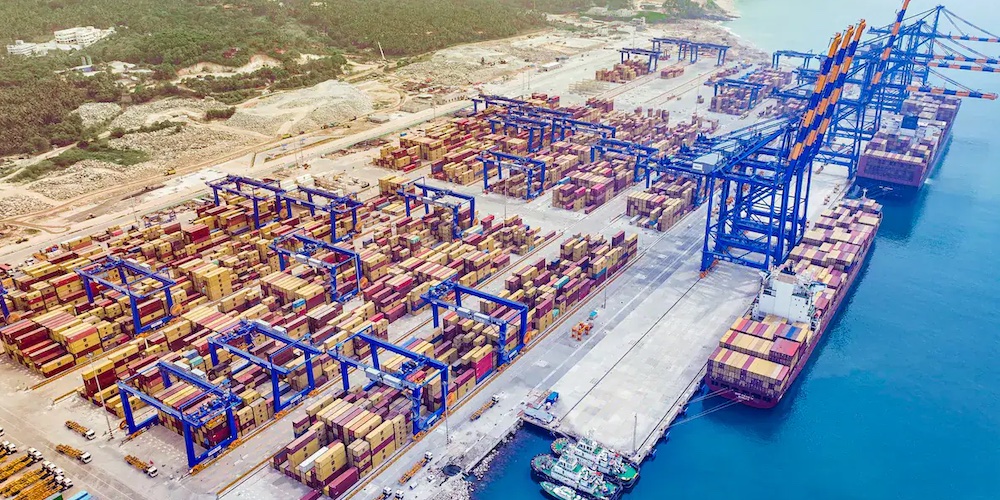India’s Maritime Vision

The Vizhinjam International Seaport is expected to transform India’s role in international trade and shipping
The erosion of Washington’s maritime security in the Indo-Pacific undermines its economic influence and strategic control of global trade flows. The foundation of its obstacles is rooted visibly in their economic pinpricks. Besides, Beijing’s rising dominance over strategically critical Indo-Pacific waterways and trade routes will pose a challenge for America and India. America’s challenges will not only deter their development but also beleaguer India’s position in determining the future of the Global South.
To counter both issues simultaneously, India has reimagined their formulation of maritime policies that secure India’s firm standing in international trade routes and engineer a strategic mechanism to monitor Chinese Naval Operations in the Indo-Pacific.
The Maritime India Vision 2030 (MIV) sets an unwavering precedent on countering Beijing’s covert dominance strategies in the Indian Ocean, focusing primarily on expanding the landscape for international trade, rebuilding port architecture, modernizing existing technologies and bolstering collaboration with ASEAN countries.
Furthermore, MIV 2030 emphasizes developing cruise tourism circuits across vital coastal countries in the region that would prove imperative in disconnecting China’s unmonitored growth in the regions.
A comparable effective outcome of the MIV 2030 is the recently developed Vizhinjam Deep Water Sea Port in Kerala. Equipped with cutting-edge technologies and expansive berths that go deeper than 24 meter, Vizhinjam port is an example of the modernizing maritime architecture of India. Vizhinjam is one of the few Indian ports that hold mother vessels also called Ultra Large Container Vessels (ULCVs), capable of holding amounts exceeding 20,000 TEU.
The Vizhinjam International Deepwater seaport is a major infrastructure project designed to handle container transshipment, multi-purpose, and bulk cargo. It is being developed on a landlord model with Public Private Partnership, utilizing a “design, build, finance, operate, and transfer” (DBFOT) basis. It was recently inaugurated officially by Prime Minister Narendra Modi . It was completed at an estimated cost of Rs 8,867 crore.

The deep-water port has been developed by Adani Ports and Special Economic Zone Ltd (APSEZ), India’s largest port developer and part of the Adani Group, under a public-private partnership. The seaport had received its commercial commissioning certificate on December 4, 2024.
According to the International Institute of Marine Surveying, the developments of the MIV 2030 have increased the maritime traffic handled by India from only 885 M TPA in 2010-11 to a massive 1300 M TPA in 2019-20.
Vizhinjam Port’s strategic proximity to the Linchpin East-West Waterway establishes it as a maritime hub, naturally serving as a gateway to connect with Europe, Asia, and the Middle East. Besides, this comes at a time when China is building strategic relationships, financing, and implanting its political proxies in Sri Lanka, Myanmar and the Maldives, expanding naval influence around India and exposing it from multiple fronts.
A healthy India-US partnership will serve twin objectives. First, they would draw Washington into deepening maritime relations with India, presenting Vizhinjam and related projects under MIV 2030 as alternatives to align with both nations’ economic recovery goals. As the US seeks new revenue corridors to mitigate internal debt, leveraging India’s maritime infrastructure offers a low-risk, high-return path — both financially and geopolitically.
Secondly, advertising Vizhinjam’s technological prowess and geographical advantages to American partners would strategically redirect maritime traffic away from China-backed ports in Hambantota in Sri Lanka and Male in the Maldives. Given Vizhinjam’s proximity to the East-West waterways, it allows for faster transshipment, reduced transport cost and equally advanced trade technologies – all without falling into China’s debt diplomacy traps. For regional actors aiming to balance between the US and China, the current crisis acts as an economic incentive to realign with India.

(Arnav Singh is a student of Class XI in Army Public School, Pune. He is an avid reader and has keen interest in Geopolitics)



Dear Arnav
Really insightful & well articulated.
Well written on a subject which has strategic implication.